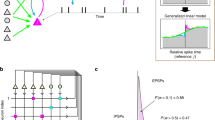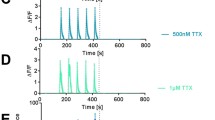Abstract
Many mechanisms of neural processing rely critically upon the synaptic connectivity between neurons. As our ability to simultaneously record from large populations of neurons expands, the ability to infer network connectivity from this data has become a major goal of computational neuroscience. To address this issue, we employed several different methods to infer synaptic connections from simulated spike data from a realistic local cortical network model. This approach allowed us to directly compare the accuracy of different methods in predicting synaptic connectivity. We compared the performance of model-free (coherence measure and transfer entropy) and model-based (coupled escape rate model) methods of connectivity inference, applying those methods to the simulated spike data from the model networks with different network topologies. Our results indicate that the accuracy of the inferred connectivity was higher for highly clustered, near regular, or small-world networks, while accuracy was lower for random networks, irrespective of which analysis method was employed. Among the employed methods, the model-based method performed best. This model performed with higher accuracy, was less sensitive to threshold changes, and required less data to make an accurate assessment of connectivity. Given that cortical connectivity tends to be highly clustered, our results outline a powerful analytical tool for inferring local synaptic connectivity from observations of spontaneous activity.








Similar content being viewed by others
References
Baldi, P., Brunak, S., Chauvin, Y., Andersen, C. A. F., & Nielsen, H. (2000). Assessing the accuracy of prediction algorithms for classification: an overview. Bioinformatics, 16, 412–424.
Becchetti, A., Gullo, F., Bruno, G., Dossi, E., Lecchi, M., & Wanke, E. (2012). Exact distinction of excitatory and inhibitory neurons in neural networks: a study with GFP-GAD67 neurons optically and electrophysiologically recognized on multielectrode arrays. Frontiers in Neural Circuits, 6, 63.
Beggs, J. M., & Plenz, D. (2003). Neuronal avalanches in neocortical circuits. Journal of Neuroscience, 23, 11167–11177.
Brette, R., & Gerstner, W. (2005). Adaptive exponential integrate-and-fire model as an effective description of neuronal activity. Journal of Neurophysiology, 94, 3637–3642.
Cocco, S., Leibler, S., & Monasson, R. (2009). Neuronal coupling between retinal ganglion cells inferred by efficient inverse statistical physics methods. Proceedings of the National Academy of Sciences of the United States of America, 106, 14058–14062.
Cossart, R., Aronov, D., & Yuste, R. (2003). Attractor dynamics of network UP states in the neocortex. Nature, 423, 283–288.
Destexhe, A., & Paré, D. (1999). Impact of network activity on the integrative properties of neocortical pyramidal neurons in vivo. Journal of Neurophysiology, 81, 1531–1547.
Destexhe, A., Mainen, Z. F., & Sejnowski, T. J. (1998). Kinetic models of synaptic transmission. In C. Koch & I. Segev (Eds.), Methods in neural modeling (pp. 1–25). Cambridge, MA: MIT.
Destexhe, A., Rudolph, M., Fellous, J. M., & Sejnowski, T. J. (2001). Fluctuating synaptic conductances recreate in vivo-like activity in neocortical neurons. Neuroscience, 107, 13–24.
Erisir, A., Lau, D., Rudy, B., & Leonard, C. S. (1999). Function of specific K + channels in sustained high-frequency firing of fast-spiking neocortical interneurons. Journal of Neurophysiology, 82, 2476–2489.
Fawcett, T. (2006). An introduction to ROC analysis. Pattern Recognition Letters, 27, 861–874.
Field, G. D., Gauthier, J. L., Sher, A., Greschner, M., Machado, T. A., Jepson, L. H., et al. (2010). Functional connectivity in the retina at the resolution of photoreceptors. Nature, 467, 673–677.
Friston, K. J. (2011). Functional and effective connectivity: a review. Brain Connect, 1, 13–36.
Garofalo, M., Nieus, T., Massobrio, P., & Martinoia, S. (2009). Evaluation of the performance of information theory-based methods and cross-correlation to estimate the functional connectivity in cortical networks. PloS One, 4, e6482.
Gerhard, F., Pipa, G., Lima, B., Neuenschwander, S., & Gerstner, W. (2011). Extraction of network topology from multi-electrode recording: is there a small-world effect? Frontiers in Computational Neuroscience, 5, 4.
Gerstner, W., & Kistler, W. M. (2002). Spiking neuron models: single neurons, populations, plasticity. Cambridge: Cambridge University Press.
Gourevitch, B., & Eggermont, J. (2007). Evaluating information transfer between auditory cortical neurons. Journal of Neurophysiology, 97, 2533–2543.
Gupta, A., Wang, Y., & Markram, H. (2000). Organizing principles for a diversity of GABAergic interneurons and synapses in the neocortex. Science, 287, 273–278.
Ikegaya, Y., Aaron, G., Cossart, R., Aronov, D., Lampl, I., Ferster, D., et al. (2004). Synfire chains and cortical songs: temporal modules of cortical activity. Science, 304, 559–564.
Ito, S., Hansen, M. E., Heiland, R., Lumsdaine, A., Litke, A. M., & Beggs, J. M. (2011). Extending transfer entropy improves identification of effective connectivity in a spiking cortical network model. PloS One, 6, e27431.
Jolivet, R., Rauch, A., Lüscher, H. R., & Gerstner, W. (2006). Predicting spike timing of neocortical pyramidal neurons by simple threshold models. Journal of Computational Neuroscience, 21, 35–49.
Kitano, K., & Fukai, T. (2007). Variability v.s. synchronicity of neural activity local cortical network models with different wiring topologies. Journal of Computational Neuroscience, 23, 237–250.
Kobayashi, R., & Shinomoto, S. (2007). State space method for predicting the spike times of a neuron. Physical Review. E, Statistical, Nonlinear, and Soft Matter Physics, 75, 011925.
Kobayashi, R., Tsubo, Y., & Shinomoto, S. (2009). Made-to-order spiking neuron model equipped with a multi-timescale adaptive threshold. Frontiers in Computational Neuroscience, 3, 9.
Kulkarni, J. E., & Paninski, L. (2007). Common-input models for multiple neural spike-train data. Network, 18, 375–407.
Kummer, M., Kirmse, K., Witte, O. W., & Holthoff, K. (2012). Reliable in vivo identification of both GABAergic and glutamatergic neurons using Emx1-Cre driven fluorescent reporter expression. Cell Calcium, 52, 182–189.
Marquardt, D. W. (1963). An algorithm for least-squares estimation of nonlinear parameters. SIAM Journal on Applied Mathematics, 11, 431–441.
Mensi, S., Naud, R., Pozzorini, C., Avermann, M., Petersen, C. C. H., & Gerstner, W. (2012). Parameter extraction and classification of three cortical neuron types reveals two distinct adaptation mechanisms. Journal of Neurophysiology, 107, 1756–1775.
Morrison, A., Straube, S., Plesser, H. E., & Diesmann, M. (2007). Exact subthreshold integration with continuous spike times in discrete-time neural network simulations. Neural Computation, 19, 47–79.
Nauhaus, I., Busse, L., Carandini, M., & Ringach, D. L. (2009). Stimulus contrast modulates functional connectivity in visual cortex. Nature Neuroscience, 12, 70–76.
Neymotin, S. A., Jacobs, K. M., Fenton, A. A., & Lytton, W. W. (2011). Synaptic information transfer in computer models of neocortical columns. Journal of Computational Neuroscience, 30, 69–84.
Ohiorhenuan, I. E., & Victor, J. D. (2011). Information-geometric measure of 3-neuron firing patterns characterizes scale-dependence in cortical networks. Journal of Computational Neuroscience, 30, 125–141.
Okatan, M., Wilson, M. A., & Brown, E. N. (2005). Analyzing functional connectivity using a network likelihood model of ensemble neural spiking activity. Neural Computation, 17, 1927–1961.
Paninski, L. (2004). Maximum likelihood estimation of cascade point-process neural encoding models. Network, 15, 243–262.
Perin, R., Berger, T. K., & Markram, H. (2011). A synaptic organizing principle for cortical neuronal groups. Proceedings of the National Academy of Sciences USA, 108, 5419–5424.
Perkel, D. H., Gerstein, G. L., & Moore, G. P. (1967). Neural spike trains and stochastic point processes II. Simultaneous spike trains. Biophysical Journal, 7, 419–440.
Petersen, C. C. H. (2002). Short-term dynamics of synaptic transmission within the excitatory neuronal network of rat layer 4 barrel cortex. Journal of Neurophysiology, 87, 2904–2914.
Pillow, J. W., Shlens, J., Paninski, L., Sher, A., Litke, A. M., Chichilnisky, E. J., et al. (2008). Spatio-temporal correlations and visual signalling in a complete neuronal population. Nature, 454, 995–999.
Platkiewicz, J., & Brette, R. (2010). A threshold equation for action potential initiation. PLoS Computational Biology, 6, 1000850.
Schreiber, T. (2000). Measuring information transfer. Physical Review Letters, 85, 461–464.
Shinomoto, S. (2010). Fitting a stochastic spiking model to neuronal current injection data. Neural Networks, 23, 764–769.
Shlens, J., Field, G. D., Gauthier, J. L., Grivich, M. I., Petrusca, D., Sher, A., et al. (2006). The structure of multi-neuron firing patterns in primate retina. Journal of Neuroscience, 26, 8254–8266.
Song, S., Sjöström, P. J., Reigl, M., Nelson, S., & Chklovskii, D. B. (2005). Highly nonrandom features of synaptic connectivity in local cortical circuits. PLoS Biology, 3, e68.
Sporns, O., & Zwi, J. D. (2004). The small world of the cerebral cortex. Neuroinformatics, 2, 145–162.
Stetter, O., Battaglia, D., Soriano, J., & Geisel, T. (2012). Model-free reconstruction of excitatory neuronal connectivity from calcium imaging signals. PLoS Computational Biology, 8, e1002653.
Takahashi, N., Sasaki, T., Matsumoto, W., Matsuki, N., & Ikegaya, Y. (2010). Circuit topology for synchronizing neurons in spontaneously active networks. Proceedings of the National Academy of Sciences of the United States of America, 107, 10244–10249.
Tang, A., Jackson, D., Hobbs, J., Chen, W., Smith, J. L., Patel, H., et al. (2008). A maximum entropy model applied to spatial and temporal correlations from cortical networks in vitro. Journal of Neuroscience, 28, 505–518.
Truccolo, W., Eden, U. T., Fellows, M. R., Donoghue, J. P., & Brown, E. N. (2005). A point process framework for relating neural spiking activity to spiking history, neural ensemble, and extrinsic covariate effects. Journal of Neurophysiology, 93, 1074–1089.
Tsodyks, M., & Markram, H. (1997). The neural code between neocortical pyramidal neurons depends on neurotransmitter release probability. Proceedings of the National Academy of Sciences of the United States of America, 94, 710–723.
Tsodyks, M., Uziel, A., & Markram, H. (2000). Synchrony generation in recurrent networks with frequency-depedent synapses. Journal of Neuroscience, 20, RC50.
Wang, X. J., & Buzsáki, G. (1996). Gamma oscillation by synaptic inhibition in a hippocampal interneuron network model. Journal of Neuroscience, 16, 6402–6413.
Watts, D. J., & Strogatz, S. H. (1998). Collective dynamics of ‘small-world’ networks. Nature, 393, 440–442.
Yamauchi, S., Kim, H., & Shinomoto, S. (2011). Elemental spiking neuron model for reproducing diverse firing patterns and predicting precise firing times. Frontiers in Computational Neuroscience, 5, 42.
Yger, P., Boustani, S. E., Destexhe, A., & Frégnac, Y. (2011). Topologically invariant macroscopic statistics in balanced networks of conductance-based integrate-and-fire neurons. Journal of Computational Neuroscience, 31, 229–245.
Acknowledgements
This study is partially supported by Support Center for Advanced Telecommunications Technology Research (RK) and by JSPS KAKENHI Grant Number 21700334 (KK).
Author information
Authors and Affiliations
Corresponding author
Additional information
Action Editor: A. Compte
Electronic supplementary material
Below is the link to the electronic supplementary material.
Figure S1
Raster displays during an episodic burst and dependence of firing rates and Cvs on locations. ( A ) Raster plots during an episodic burst for the various network topologies. Spatial distributions of the averaged firing rates ( B ) and Cvs ( C ). The unit of color scale in ( B ) is spike/s. (JPEG 584 kb)
Rights and permissions
About this article
Cite this article
Kobayashi, R., Kitano, K. Impact of network topology on inference of synaptic connectivity from multi-neuronal spike data simulated by a large-scale cortical network model. J Comput Neurosci 35, 109–124 (2013). https://doi.org/10.1007/s10827-013-0443-y
Received:
Revised:
Accepted:
Published:
Issue Date:
DOI: https://doi.org/10.1007/s10827-013-0443-y




